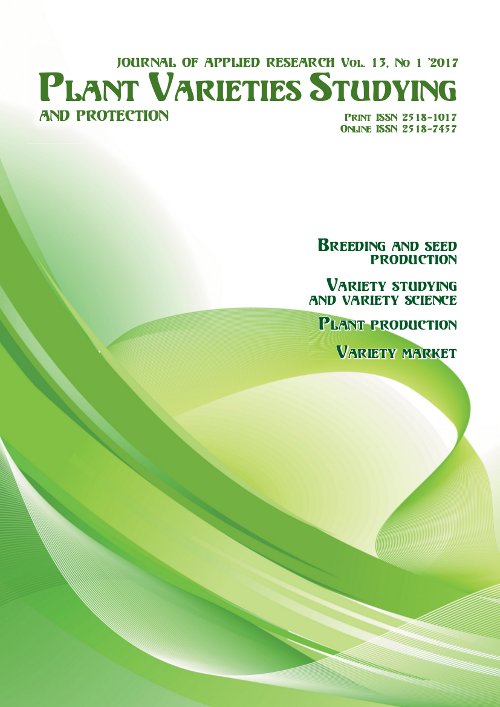Peculiarities of productivity formation of the genus Salix L. representatives
DOI:
https://doi.org/10.21498/2518-1017.13.1.2017.97191Keywords:
productivity, dry biomass, height, diameter, number of shoots, correlation relationship, cluster analysisAbstract
Purpose. To identify the productivity of the genus Salix L. plants and study the relationship between its structural elements. Methods. Field study, laboratory analysis, analytical approach.
Results. It was found that the height of a three-year plants of species ranged from 86.0 to 775.1 cm, of hybrid forms – from 197.0 to 488.0 cm. Average diameter of three-year plants varied in the range of 19.10 to 52.94 mm (species) and from 28.04 to 49.23 mm (hybrid forms). The highest stability for complex of morphological characters was observed in bog willow samples. It was determined that among species basket willow (16.94 t/ha) and white willow (21.19 t/ha) were the most productive for dry biomass yield per 1 hectare, among hybrid forms – purple willow × basket willow (23.36 t/ha) and basket willow × bog willow (18.57 t/ha). It was established that the value of the plants productivity was characterized by moderate, significant and close correlations with the average diameter of plants, length and number of shoots of the second order.
Conclusions. A comprehensive assessment of productivity traits of three-year plants from willow collection was conducted, index of dry matter yield per 1 hectare was defined. The links between quantitative traits that characterize the contribution of some of them in productivity index were investigated. Method of cluster analysis was used to group samples for the similarity of complex agronomic characters. Basket willow and white willow as well as such hybrid forms as basket willow × bog willow and purple willow × basket willow were recommended to use as a source material for selection of samples with high productivity.
Downloads
References
Hordiienko, M. I., Fuchylo, Ya. D., & Haichuk, A. F. (2002). Chaharnykovi verby rivnynnoi chastyny Ukrainy (biolohiia, ekolohiia, vykorystannia) [Shrubby willows in plains of Ukraine (biology, ecology, use)]. Kyiv: N.p. [in Ukrainian]
Fuchylo, Ya. D., Onyskiv, M. I., & Sbytna, M. V. (2006). Biologichni ta tehnologichni osnovi plantatsiynogo lisoviroschuvannya [Biological and technological basis of planted forest cultivation]. Kyiv: N.p. [in Ukrainian]
Rodkin, O. I. (2015). Ecological and physiological aspects of willow cultivation of as a source of wood biomass. Naučnyj žurnal NIU ITMO. Seriâ Èkonomika i èkologičeskij menedžment [Scientific journal NRU ITMO. Series “Economics and Environmental Management”], 3, 377–384. [in Russian]
Fuchylo, Ya. D., Sbytna, M. V., & Derkach, D. F. (2007). Prospects of Salix L. species use for energy plantations in Ukraine. Ukrainskyi fitotsenolohichnyi zbirnyk [Ukrainian Phytosociological Collection], 25, 97–102. [in Ukrainian]
Onyskiv, M. I., Fuchylo, Ya. D., & Sbytna, M. V. (1999). Features of the creation of fast-growing tree species plantations. Naukovyi visnyk NAU [Scientific Herald of NAU], 20, 81–87. [in Ukrainian]
Shcherbyna, O. M. (2011). Verba enerhetychna: vykorystannia ta vyroshchuvannia [Energy willow: the use and cultivation]. Uzhhorod: Vydavnytstvo V. Podiaka. [in Ukrainian]
Tkachov, O. I., & Viryovka, V. M. (2011). Features of afforestation on the drained peat lands in Forest-Steppe zone. Zemlerobstvo [Agriculture], 83, 47–53. [in Ukrainian]
Hordiienko, M. I., Maurer, V. M., & Kovalevskyi, S. B. (2000). Metodychni vkazivky do vyvchennia ta doslidzhennia lisovykh kultur [Methodological guidelines for forest plantation study and research]. Kyiv: Lybid. [in Ukrainian]
Ermantraut, E. R., Prysiazhniuk O. I., & Shevchenko, I. L. (2007). Statystychnyi analiz ahronomichnykh doslidnykh danykh v paketi Statistica 6.0. [Statistical analysis of agronomic investigations data in the Statistica 6.0 software suite]. Kyiv: PolihrafKonsaltynh [in Ukrainian]
Downloads
Published
How to Cite
Issue
Section
License
Copyright (c) 2017 В. В. Баликіна

This work is licensed under a Creative Commons Attribution-ShareAlike 4.0 International License.
Our journal abides by the CREATIVE COMMONS copyright rights and permissions for open access journals.
Authors, who are published in this journal, agree to the following conditions:
1. The authors reserve the right to authorship of the work and pass the first publication right of this work to the journal under the terms of a Creative Commons Attribution License, which allows others to freely distribute the published research with the obligatory reference to the authors of the original work and the first publication of the work in this journal.
2. The authors have the right to conclude separate supplement agreements that relate to non-exclusive work distribution in the form in which it has been published by the journal (for example, to upload the work to the online storage of the journal or publish it as part of a monograph), provided that the reference to the first publication of the work in this journal is included.


























 Ukrainian Institute for Plant Varieties Examination
Ukrainian Institute for Plant Varieties Examination  Селекційно-генетичний інститут
Селекційно-генетичний інститут Institute of Plant Physiology and Genetics of the National Academy of Sciences of Ukraine
Institute of Plant Physiology and Genetics of the National Academy of Sciences of Ukraine
 The National Academy of Agrarian Sciences of Ukraine
The National Academy of Agrarian Sciences of Ukraine